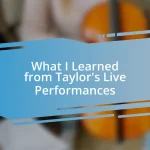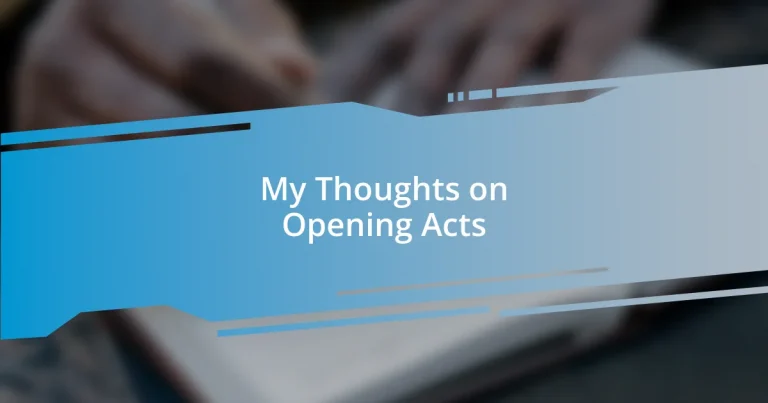Key takeaways:
- Opening acts are crucial for setting the concert atmosphere, showcasing emerging talent, and engaging the audience, enhancing the overall experience.
- Effective strategies for opening acts include thorough preparation, audience interaction, and mindful pacing to connect with the crowd and maintain energy levels.
- Aspiring opening acts should focus on honing their unique sound, networking, and learning to read audience reactions to create memorable performances.

My view on opening acts
Opening acts often get overlooked, but I truly believe they’re vital to the concert experience. I remember attending a festival where the opening act unexpectedly blew me away. Their energy and raw talent set the perfect tone for the headliners, making me appreciate the entire lineup even more.
In my experience, an opening act is like the first chapter of a great book; it draws you in and piques your curiosity about what’s to come. Have you ever felt that rush when a little-known band plays their heart out? It’s a reminder that fantastic music is everywhere waiting to be discovered.
I often find myself reflecting on how these acts can challenge the mainstream narrative. Their unique sound and perspective bring a refreshing diversity to the stage, prompting me to consider: what stories do they have to tell? In a way, their performance is an invitation to think differently and appreciate the multitude of voices in the music scene.

Importance of opening acts
Opening acts play a crucial role in setting the atmosphere for an event. I remember one night at a large arena where the anticipation was palpable, and the opening act, a local band, took the stage. Their performance, although short, was electric and left the crowd buzzing with excitement. It’s fascinating how such moments can elevate the whole experience, often leaving a lasting impression that connects fans not just to the headliner but to the whole event itself.
Here are some key reasons I find opening acts so important:
- They showcase emerging talent, often introducing the audience to artists they may not know yet.
- They create a sense of community among the audience, uniting everyone in shared discovery.
- Their unique styles can enhance the overall concert experience, enriching the atmosphere and making it more memorable.
- As a bridge between the audience and the main act, opening acts build momentum, amplifying excitement.
- They often offer a space for experimentation, allowing musicians to present their most authentic selves.

Impact on audience engagement
The impact of opening acts on audience engagement is often profound. I remember a concert where the unknown opener completely captivated the crowd. Their passion and connection with the audience made the energy in the room almost tangible, setting the stage for a memorable night.
Moreover, opening acts are a wonderful opportunity for audience interaction. I’ve seen fans cheer enthusiastically for the opener, creating an instant bond. This excitement not only warms up the crowd but also enhances the overall experience, making everyone feel like they are part of something special.
Interestingly, the diversity of opening acts can spark conversations among attendees, leading to a richer concert experience. After a show, I often find myself discussing the opener with new friends I made in the crowd. This kind of engagement not only boosts audience enjoyment but can also lead to a lasting appreciation of the music scene as a whole.
| Aspect | Impact on Engagement |
|---|---|
| Energy Level | Sets a lively tone, enhancing excitement for the main act |
| Audience Interaction | Encourages connection among fans, creating a shared experience |
| Diversity | Promotes discussions and deeper appreciation of different musical styles |

Strategies for a successful performance
When it comes to strategies for a successful performance as an opening act, one of the most significant elements is preparation. I remember a time when a friend of mine was the opener for a big-name band. He spent weeks honing his setlist, focusing not just on his best songs but also on crafting a narrative that built up excitement. This thoughtful approach transformed his performance into a journey, allowing the audience to connect deeply with the music.
Engaging with the audience is another crucial strategy. During a gig I attended, the opening act took a moment to interact, asking everyone about their favorite songs. This personal touch created an immediate connection, encouraging the crowd to cheer loudly and embrace the show. I’ve learned that when an opening act makes the audience feel involved, it elevates the energy levels and creates a welcoming atmosphere for the headliner.
Lastly, being mindful of pacing can make a significant impact. I distinctly recall a performance where the opener varied the tempo throughout their set, transitioning from a heart-wrenching ballad to an upbeat anthem. This contrast kept the audience on their toes and fully invested in the experience. It’s this kind of intentional pacing that can leave a lasting impression, making the audience eager for what comes next.

Tips for aspiring opening acts
To make a mark as an aspiring opening act, honing your unique sound is essential. I once watched a budding band that had a raw, authentic vibe. They may not have had the polish of seasoned artists, but their originality resonated deeply with the audience. I believe when musicians embrace their individuality, it invites connection and curiosity from listeners.
Networking can also be a game-changer. I recall attending a local showcase where one of the opening acts not only played well but also mingled with attendees afterward. Their willingness to chat left a lasting impression on fans, some of whom even followed them on social media right there on the spot. Isn’t it fascinating how one sincere conversation can amplify your presence in the music scene?
Finally, learning to read the room can take your performance to the next level. During a festival, I witnessed an opener who adjusted their set based on audience reactions. They began with a slow ballad, but when they sensed the crowd thirsted for energy, they swiftly shifted to a high-tempo track that had everyone dancing. This adaptability made the performance memorable and kept the excitement alive. It’s something every aspiring artist should strive to master.












